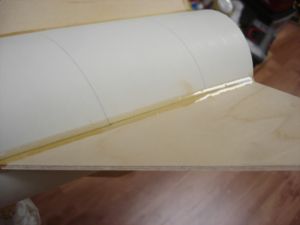| Construction Rating: | starstarstarstarstar_border |
| Flight Rating: | starstarstarstarstar |
| Overall Rating: | starstarstarstarstar_border |
| Diameter: | 4.00 inches |
| Length: | 45.75 inches |
| Manufacturer: | LOC/Precision  |
| Style: | Sport |

Brief:
This is a large mid and high powered rocket which is a very good transition
into HPR. I purchased this kit for the EMRR Hit List and used it to obtain my
NAR Lever 1 Certification. It's a great kit that is very strong with the basic
three fins, body, and a nose cone.
Construction:
The kit comes with a 34" long by 4" diameter slotted body tube,
4" diameter nose cone, three strong plywood fins with tabs all the way to
the motor tube, an 18" long by 38mm motor tube, two 3/16" plywood
centering rings, a standard LOC/Precision shock cord mount, a 15' shock cord, a
36" parachute, and a 1/4" and 1/2" launch lugs (you can pick
which one you wish to use). All of the parts fit together fine when test fitted
and no problems were found. The shock cord just ties onto the plastic eyelet in
the nose cone. A screw eye could be added to the nose cone if it is preferred.
The instructions were like other LOC/Precision kits. They are printed on one side of a sheet of paper without many diagrams at all. The build is relatively simple for a HPR. Since I had done work on LOC kits in the past, I didn't follow their instructions during the build and simply did things in the order that I preferred. The one thing that I did do different from the provided instructions is in the insertion of the aft centering ring. The instructions have you epoxy both centering rings in place before putting the fins on. This only gives a bond with the fins and inside of the rocket that is equal to the amount of epoxy you can fit on the bottom of the fin tab. I prefer to leave it out and epoxy the fins in first so that I can apply fillets to the fins on the inside of the main airframe as well as the outside. This is for added strength and to give me a little extra confidence in my hard work when it gets out on the pad. After beveling the fins and gluing them in place, I applied generous epoxy fillets on the inside and outside of the airframe and where the fin tabs meet the motor tube. Before epoxying the aft centering ring in after all the fillets on the fins were done, I drilled three holes in it and epoxied T-nuts into them for my motor retention system. The recovery system goes on with the LOC shock cord mount which has always worked fine for me. I did add a sheet of 12" x 12" Nomex® to the shock cord before tying it off to protect the parachute. I went with the 1/2" launch lug that came with the kit since it provides much more rigid guidance than the 1/4" rod. Overall the construction is very simplistic and standard with nothing standing out as tricky.


Finishing:
I sanded all of the parts of the rocket except for the nose cone prior to
painting. I only painted it with some cheap spray paint, doing the body and
fins white and the nose cone green. There are decals for the kit but they must
be downloaded off the internet and printed out on waterslide decal paper. I
hope to do this in the future so I painted the kit like it is pictured with the
decals except I must go back and paint the fins black. It looks like a great
kit and looks even better on the pad.
Construction Rating: 4 out of 5
Flight:
The recommended motors are the F50-6, G80-7, H97J-M, and H123W-M. I have seen I
motors recommended for it in some places and I know that I will end up flying a
few I's in it. For it's first flight, I flew it on the Aerotech H128W-M. This
was my level 1 certification flight and I got the motor and casing in the
Aerotech Level 1 deal. I prepped the motor under the supervision of our club
president. The motor construction is basically the same as that of the hobby
line reload systems. The prep for this rocket doesn't take long. Putting the
motor together takes the most time. Since I added the Nomex®
sheet in my kit, it did not require any wadding. I lined the T-nuts up in my
centering ring for the Rocketman 38mm aft closure. Since I flew it on a 29mm
motor with an adapter, I cut out a ring out of strong aluminum that lined up
with the T-nuts and rested all the way around the bottom of the aft closure. I
tightened it down with 3 bolts, and that motor was not going anywhere. After
the button was pushed, the rocket had a perfectly straight boost. It flew
beautifully and the nose cone popped off and the parachute came out perfectly
at apogee. It was a wonderful sight to see. I sure had some second thoughts and
an upset tummy when they announce to everyone that it's a level 1 cert flight
but watching it put all my doubts away.
Recovery:
The shock cord was tied to the eyelet in the nose cone and attached to the
airframe with the LOC shock cord mount. This mount is just a piece of Kevlar®
cord that you tie a knot in each end and a loop in the middle of it. The shock
cord is tied to the loop and the knots are epoxied into the inside of the
airframe. It is very easy to assemble and I have never had any trouble
assembling it or with its use. The recovery after flight was perfect. The
36" parachute brought it down at just the right speed and I didn't have a
very long walk at all to get to the kit. There was a little bit of burn marks
on the Nomex®
cloth but no marks at all on the parachute. The shock cord and parachute still
looked like they had never been flown. The rocket was recovered without even a
scratch anywhere on it. It really was a perfect certification flight!
Flight Rating: 5 out of 5
Summary:
This is a great high power rocket kit. It is the basic 3 fins, body, and nose
cone kit, but it is very strongly built and will last many flights. It has
perfectly straight boosts and has a good recovery system. With some added motor
retention and a Nomex®
cloth in the recovery system, I know this will become the workhorse of my new
high power fleet.
Overall Rating: 4 out of 5
Other Reviews
- LOC/Precision Fantom 438 By Mason Hazzard (July 20, 2012)
A 4" diameter rocket with a 38mm motor mount that is perfect for Level One Certification or someone just getting into HPR. Components The kit includes two 1/4" rings, a slotted body tube, motor mount tube, 3x1/8" plywood fins, a LOC shock cord and mount, and a nose cone, launch lug, and a 36" parachute. I had to separately but eye bolys, quicklinks, a retainer, rail buttons, a ...
 |
 |
Flights
 |
 |